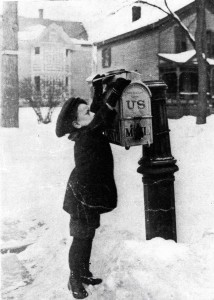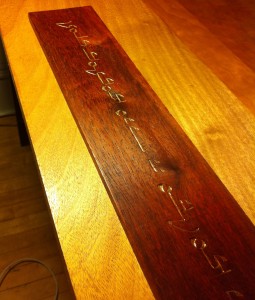When I first started the Champlain College Publishing Initiative, I had a list of things I wanted to achieve and another list of things I wanted to avoid. At the top of my things to avoid was warehousing. I’ve known too many writers with boxes of their own unsold books in their basements, garages or attics, the pages foxing with mildew, swelling with damp, smelling more and more strongly of mold until the writer couldn’t help starting to think that it was his own writing that stank. In fact, I’ve been one of those writers.
So I was determined to avoid warehousing, and along with warehousing I wanted to avoid packing, shipping, trucking, and all the rest of the services summed up by the all-too-rectal phrase “back end.” I wanted customers to be able to order our books from some printing-plus operation that would do all that dirty work out of my sight, and all we’d know of the transaction was that every so often a check would arrive. I didn’t care if the check wasn’t all that big as long as I didn’t have to deal with the back end.
So the first few books we ushered into being were indeed printed by printing-plus operations—Lulu, Blurb, the Northshire Bookstore in Manchester, Vermont—and sure enough they took care of our fulfillment needs. My garage filled up with the things that naturally migrate into garages (tires, leaves, squirrel droppings, left-handed gardening gloves), my attic filled up with things that naturally migrate into attics (discarded clothing, overstuffed envelopes of two-year-old business receipts, mice for computers long obsolete), and my basement filled up with the things that naturally migrate into basements (cobwebs, old pairs of ice skates, individual socks dropped on the way to or from the laundry). It wasn’t entirely an orderly life, but at least I wasn’t forced to face shelves of reproachful, unsold, mildewing books.
Meanwhile, my older daughter Zoe was tackling the same problems with her first design line since graduating from the Rhode Island School of Design. She had created a series of designs that she had transferred to medium plates, small plates, and saucers, and now the Christmas orders were starting to come in, she had to start working out how to pack and ship fragile, inflexible products through the mail at the most insane and brutal time of the postal year.
The strange thing was—she seemed to be enjoying it. She contacted a number of packaging companies and designed her own cardboard sleeves for the plates. She played around with labels and stamps. The orders came in and went out, and we heard no reports that she had tripped over a stack of salad plates and fallen downstairs—or, just as bad, kicked the plates downstairs. She was no longer just a designer: she was an Industry.
Soon afterwards, I self-published my most recent book, Endangered Alphabets. It wasn’t a plate, but it was beautiful and, like all books, somewhat fragile. I couldn’t print-plus it through my no-back-end printers because either they couldn’t handle the 8×10 landscape format or I didn’t trust them to produce anything as elegant as I imagined. So I went with a printer that did excellent work and could offer me a print run of as few as 25 books (Mira Digital Publishing) and in addition decided not to sell the book through bookstores or Amazon, and instead to sell it only through its own website. I resigned myself to the fact that now I had no choice: I had to be my own back end.
To my amazement, I found myself enjoying it. For the first time in a 12-book career, I was now aware of every single book I sold. Not only that, but every book, whether I sold it through the website or at an exhibition of the Endangered Alphabets, became personal. So far I’ve not only signed every book, but in most cases I’ve personalized them with an inscription. Far more than ever before, I know the life of my books after they leave my hands: one is on its way to Alice Springs, in the heart of Australia. Who’d have guessed? And to a remarkable extent, I also know my buyer-readers—and that means every padded mailer, every piece of bubble-wrap, every trip to the Post Office gives a new meaning to the term “fulfillment”: it has the feel of giving a gift.
Luckily, sales so far have been both modest and smooth. I’m not sure how well I’d cope if I started getting a thousand orders a week. But right now the living-room bookshelf has a neat stack of some 20 copies of this beautiful book, and they’ll all be gone long before the mold sets in. I have a pretty good idea when to order the next box, and when to buy the next pack of padded envelopes from the dollar store.
Napoleon taunted the British as “a nation of shopkeepers,” but I’m quite liking the insult.I feel more like a pub-keeper than a publisher: selling involves as much meeting and chatting as it does packing and shipping. The back end is front and center, and I love it.


